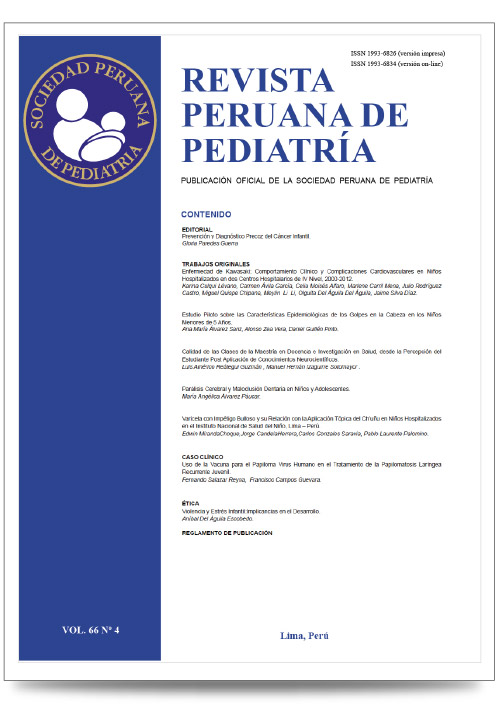Cerebral Palsy and Dental Malocclusion in Children and Adolescents
DOI:
https://doi.org/10.61651/rped.2013v66n4p234-241Keywords:
Cerebral Palsy, Malocclusion, Malocclusion, Angle Class I, Malocclusion, Angle Class II, Malocclusion, Angle Class IIIAbstract
Disability is classified into 04: motor, sensory, mental and associative, the most representative in the first group, cerebral palsy (CP), causing a public health problem. This patients, shows a marked change in chewing, breathing, swallowing and phonation, which influence on the stomatognathic system.
Objective: Identify the type of malocclusion exists in children and adolescents with CP from specialized national reference centers.
Methods: The research is descriptive and transversal. The sample consisted of 171 children and adolescents with CP, aged between 6- 19 years, from the National Institute of Rehabilitation "Adriana Rebaza Flores" and HogarClínica San Juan de Dios, during the period 2012. Met the inclusion criteria, one of the prerequisites, the presence of the keymolar (first permanent molar in occlusion). For data collection, a form of clinical evaluation for the registration of occlusion and type of malocclusion Angle or Molar Relationship (MR) was used. Established ethical standards were met. Chi Square and measures of central tendency of the statistical package SPSS 19 was used.
Results: The characteristic age was mainly associated with MR, the age group (from 6.0 to 11.9 years), won malocclusion Class I. Also, the age group (12-19 years) showed mainly malocclusion Class III. Also, age was associated with an overbite (OB), where the age group (from 6.0 to 11.9 years), showed cases of change in dentition, unrecorded cases (NR) with 33.3% and the groups of 12 to 19 years) reported mainly OB normal with 40,0%.
Conclusion: Exist dental malocclusion (Class II, Class III)in 74.3%, while 25.7% had no dental malocclusion category (BilateralClass I). The group of 6.0 to 11.9 years recorded aMR Class I and the group of 12 to 19 years obtained mainly ClassIII MR.
Downloads
Downloads
Published
How to Cite
Issue
Section
Categories
License

This work is licensed under a Creative Commons Attribution 4.0 International License.
Authors will retain the copyright and grant the right to publish their work in the journal while allowing third parties to share it under the Creative Commons Attribution license.
Articles are published under a Creative Commons license that allows sharing and adaptation with appropriate credit. CC BY 4.0 license. Available in English at https://creativecommons.org/licenses/by/4.0/
Authors may use other information disclosure formats as long as the initial publication in the journal is cited. The dissemination of the work through the Internet is recommended to increase citations and promote academic exchanges.
The published content does not necessarily reflect the specific point of view of the journal, and the authors assume full responsibility for the content of their article.




